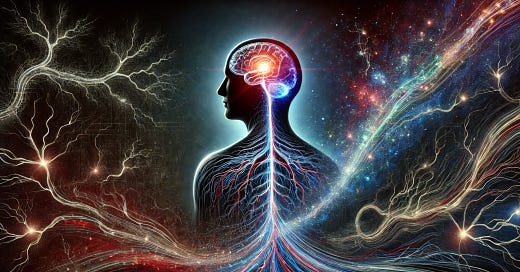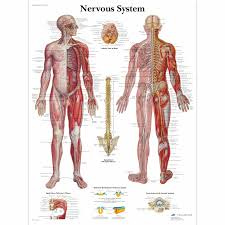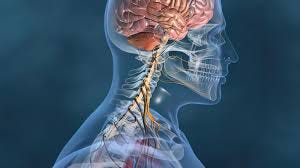“Your Nervous System Doesn’t Lie” — Except It Absolutely Does 🧠
The neuroscience behind why you shouldn't always trust your gut. (9min Read)
TL;DR Summary:
Your nervous system isn’t a truth-teller—it’s a prediction machine, and trauma distorts its accuracy.
Neuroception can mistake safety for threat, leading to false “gut feelings.”
Intuition, insight, instinct, and neuroception are not the same—knowing the difference matters.
Unblending from your Parts (IFS) helps you pause, assess, and lead from clarity, not fear.
With practice, your gut can become wise again—and your nervous system can relearn what safe feels like.
Your Nervous System Doesn’t Lie — Except When It Totally Does
You’ve heard it a thousand times: “The body never lies.”
But what if it does?
What if that gut feeling you swear is intuition… is actually just your trauma talking?
What if the sensation you’ve been calling truth is really just a glitch in your nervous system’s threat-detection software?
Because here’s the uncomfortable truth: your neuroception, the unconscious process your body uses to detect safety or danger, isn’t a divine compass.
It’s a prediction engine. And it misfires. A lot.
Especially after trauma.
Your nervous system might feel like it’s giving you truth in high definition.
But what it’s actually doing is running old code, written in fear, optimized for survival—not accuracy.
How does this wiring get messed up? How do you know what feelings and thoughts to trust?
All this and more in today’s blog.
Let’s dive in!
So what’s going on here?
Let’s start by unpacking neuroception, a term coined by trauma researcher Stephen Porges, which refers to the unconscious surveillance system your body runs 24/7 to detect safety or threats.
Unlike perception, which is conscious, neuroception happens beneath awareness and it heavily guides your behavior, your intuition, and even your gut feelings.
Sounds trustworthy, right?
But here’s the twist: neuroception is built from past experience, not just present data.
And your brain doesn’t passively “read” the world—it predicts it.
Your Brain: A Meaning-Making, Threat-Detecting Guess Machine
Imagine your brain is less like a camera and more like a weather app.
It doesn’t show you reality, it gives you its best guess about what’s happening, based on past patterns and current cues.
This is the essence of predictive coding theory, which suggests your brain uses Bayesian inference (a fancy way of saying, “update predictions based on new evidence”) to constantly update its internal model of the world.
But here's the problem:
Trauma distorts the prediction model.
If your past is filled with environments where “safe” people weren’t actually safe, your brain may now interpret kindness as manipulation, or intimacy as danger.
Think about it like this, imagine a smoke detector in a kitchen.
If it goes off every time you make toast, you don’t assume there’s always a fire.
You know the system is hypersensitive.
But when your nervous system does the same thing—panicking in safe situations—it feels like a red alert you can’t question.
Trauma turns your neuroception into an overreactive smoke alarm.
Not because it’s broken, but because it was trying to protect you in the past.
In other words, your gut feeling might not be intuition, it might be an echo of unresolved trauma.
Something I see in so many of my high-achieving clients.
They have no idea what’s really driving them to push so hard, they just feel the urge to do so and follow it blindly.
And because their brain is a prediction machine, and society generally rewards high-achieving behaviors, this pattern of ignoring unresolved trauma continues.
But Cody, Didn’t You Say We Should Trust Our Gut?
Yes. And also, no.
I recently wrote a blog about the neuroscience of intuition and clarified the difference between intuition, instinct, and insight.
Intuition is a powerful, fast-processing system built on experience and pattern recognition.
It can be sharpened over time.
But neuroception isn’t the same thing as intuition.
It’s more primitive, more automatic, and when it’s been shaped by trauma, it doesn't always update easily.
Intuition can grow wiser. Neuroception has to be retrained.
So... How Do You Know If It’s Intuition or Trauma Talking?
That’s the million-dollar question, right?
Here’s a starting framework:
Insight is what you get after reflection. It feels clear, often surprising, and calm.
Intuition is fast, experience-based, and specific, like when a nurse knows a patient is going downhill just by the look in their eyes.
Instinct is automatic, survival-based, and often rigid.
Neuroception runs all of those in the background, but it’s especially influenced by trauma, and it doesn’t come with a label telling you when it’s wrong.
If your “gut feeling” is vague, global (“Something’s wrong but I don’t know what”), or infused with panic, there’s a good chance you’re dealing with a neuroceptive misfire.
Ok, so what on earth do I listen to? I feel more confused now.
I get it, and I wouldn’t leave you hanging like that.
Here’s exactly how to recalibrate your system, and how to know what things to listen to.
How to Work with a Lying Nervous System
The number one tool is being able to detect and “unblend” from your Parts, as IFS likes to call them.
Your Parts, Protectors, and Exiles, are the ones taking over your feelings, thoughts, and actions when there’s something deeper to protect, like unresolved trauma.
Fear of rejection, abandonment, humiliation, betrayal, etc.
When they take over, and they’re trying to drive the bus, IFS would consider them blended with you.
You’ve probably felt this before, you get so angry it just takes over, or so anxious that you’re paralyzed.
This is what it feels like to be “blended” with your Parts.
Some of my clients say it feels like slime being pushed into a carpet, it completely covers and encapsulates all the fibers, and is very hard to unstick.
Parts blend with us to keep us safe, they don’t realize we’re older now, and we can handle the things happening around us.
You can tell they’re blended with you because they’re coming from a place of fear, guilt, or shame, and it feels reactive.
Making decisions from this Parts-led, or “blended” place of fear is always never helpful in the long run.
These are the “gut feelings” that you should take a beat before following blindly.
What should you do in that beat you ask? Great question.
Unblend from your Parts.
How to Unblend From Your Parts
Surprise, surprise, if you can become blended, you can also un-blend from your Parts.
This is for sure one of the top 3 tools in IFS Psychotherapy.
Once you learn how to do this, your life will never be the same.
Let’s break it down.
1. Name It Without Shaming It
Start by noticing and naming what’s coming up.
Use Parts language that creates some space between you and the feeling:
“A PART of me is feeling panicked right now.”
“There’s a PART that doesn’t trust this situation.”
“I notice a protective PART that’s sure something bad will happen.”
This simple shift from “I am anxious” to “A part of me is anxious” is powerful.
It signals to the brain that there’s you (Self) and there’s the Part.
You’re not fused anymore.
2. Get Curious, Not Controlling
Next, ask the Part gentle, curious questions, like you’re getting to know a scared child or a hypervigilant bodyguard.
For example:
“What are you afraid would happen if you didn’t speak up right now?”
“How long have you been trying to protect me this way?”
“What do you want me to understand?”
This gives the Part a chance to share its intentions, not just its emotions.
Remember, most Parts react the way they do because they’re trying to keep you safe, even if their methods are outdated.
3. Ask for Some Space
Finally, if a Part is blending heavily (you're flooded), ask it kindly to step back so you, the Self, can see more clearly.
You might say:
“Thank you for trying to help. Could you give me just a little space to assess the situation?”
“I hear you. Could you step back just a little so I can see if this is actually dangerous or if it just feels that way.”
Most Parts are relieved when Self shows up to take the lead.
You’re not exiling the Part.
You’re inviting it to shift from protector to advisor.
Some may fear you’re trying to get rid of them or replace them, be sure to assure them that this isn’t the case!
What Being Self-led Feels Like
Once you’ve done this, you’ll notice what’s underneath your Parts.
It’s what IFS calls Self-energy, and it feels calm, clear, connected, compassionate, hopeful, peaceful, present, and playful.
You’ll instantly gain confidence, courage, perspective, and creativity.
This is the place you want to make decisions from.
This is what it feels like to be Self-led.
These feelings, this Self-energy, is always with you, we just forget when our Parts blend with us.
Learning to detect, and unblend from your Parts like this is the fastest way to understand if you should follow your gut or not.
As you practice this, you trigger a prediction error in your brain.
This new experience, making a Self-led decision, doesn’t match the old fear-based prediction, and over time, it updates your system!
This also expands your window of tolerance, meaning your system is less likely to overreact in triggering situations and more able to recalibrate when it does.
Your Gut Can Become Wise Again
The truth is, your nervous system isn’t your enemy, it’s just been overworked, overwhelmed, and trying to protect you with outdated maps.
But the moment you learn to pause, unblend, and lead from Self, you begin rewriting the rules.
You stop letting fear run the show. You interrupt the cycle of false alarms.
And you teach your nervous system something powerful: Safety can feel safe again.
This isn’t about never feeling fear.
It’s about learning which signals to trust, and which ones are ghosts from the past.
Because when your system is calm and Self is in the lead, your gut does become wise.
Intuition sharpens. Insight deepens.
You move through the world with clarity instead of reactivity.
You can become the leader your nervous system has always been waiting for.
And that changes everything.
Until next time… Live Heroically 🧠
Want to Work With Me? Here Are 3 Ways I Can Help You
Join the Balanced Creator Community (free): It’s the only community on earth built to support the mental health & mindset of content creators & entrepreneurs (creatorpreneurs) while growing and monetizing their brands and businesses.
Become a paid subscriber to the Mind, Brain, Body Lab Digest: You’ll get subscriber-only video posts, email replies, access to my entire blog archive, early access to new products, workshops & tools I create!
Work With Me 1on1 Through the Me 2.0 Program: Work with me 1on1 to heal the unresolved trauma and limiting beliefs that are holding back your health, wealth & relationships. (Extremely Limited Spots; Paid Subscribers Are Prioritized on Waitlist)
Supporting Research
Barrett, L. F. (2017). How Emotions Are Made: The Secret Life of the Brain. Houghton Mifflin Harcourt.
Friston, K. (2010). The free-energy principle: a unified brain theory? Nature Reviews Neuroscience, 11(2), 127–138. https://doi.org/10.1038/nrn2787
Porges, S. W. (2011). The Polyvagal Theory: Neurophysiological Foundations of Emotions, Attachment, Communication, and Self-Regulation. Norton.
Seth, A. K. (2013). Interoceptive inference, emotion, and the embodied self. Trends in Cognitive Sciences, 17(11), 565–573. https://doi.org/10.1016/j.tics.2013.09.007
Siegel, D. J. (2012). The Developing Mind: How Relationships and the Brain Interact to Shape Who We Are. Guilford Press.


















Great writing and thinking! Restocking now!
This is really helpful, thank you!